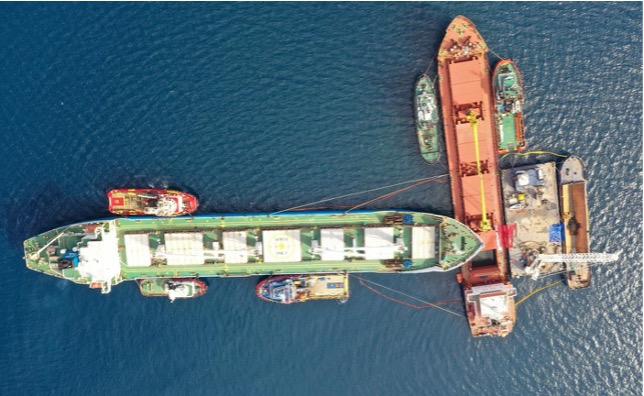

Head-On or Crossing? Clarification given by Admiralty Court on Rule 14

On Friday 16 May 2025, Mr Justice Bryan, sitting in the Admiralty Court with Commodore Dorey as Nautical Assessor delivered a thorough and detailed judgment in KIVELI c/w AFINA I – Monford Management Ltd v Afina Navigation Ltd [2025] EWHC 1185 (Admiralty) that provides significant clarification as to when Rule 14 of the Collision Regulations applies and will be welcomed by both mariners and Admiralty practitioners alike. The Judge held that it was a head on situation and that KIVELI was 80% to blame for the collision and AFINA I 20%.
Background
At around 06:01 local time on 13 March 2021 in calm weather with good visibility, KIVELI and AFINA I collided off the southern coast of Greece. Prior to the collision both vessels were passing on a fine green to green situation, with AFINA I passing the starboard side of KIVELI by 0.213 nm.
KIVELI could only see a green sidelight of AFINA I (had the Chief Officer of KIVELI been keeping a proper lookout). AFINA I could predominantly see KIVELI’s green side light but on occasions her green and red side light as the two vessels independently yawed.
At around C-6, AFINA I judging this to be a head-on situation began altering course to starboard. KIVELI altered course to port at C-1. KIVELI’s bow collided with the port side of AFINA I at an angle of approximately 90 degrees, causing immediate flooding and a serious risk of sinking. The vessels remained interlocked for 20 days whilst efforts were undertaken to recover the vessels without further damage.
Tatham & Co represented the Hull and Machinery Underwriters of AFINA I and jointly instructed Nigel Cooper KC of Quadrant Chambers.
Issues to be Determined
The principal issues to be determined by the High Court were as follows:
Whether the vessels were in a head on situation such that Rule 14 of the COLREGS applied, as argued by AFINA I; or
Whether the vessels were crossing such that Rule 15 of the COLREGS applied, as argued by KIVELI.
The Decision
The Judge agreed with AFINA I and found that Rule 14 applied.
In particular, the Judge held that Rule 14(a), where two vessels are on reciprocal or near reciprocal courses, so as to involve a risk of collision, is a definitional provision. Whereas Rule 14(b), where a vessel sees the other ahead or nearly ahead and by night she would see the masthead lights of the other in a line or nearly in a line or both sidelights, is a deeming provision.
It was held that the risk of collision was deemed to exist at C-22 minutes, when the vessels were on headings 7 off reciprocal, separated by 8.6 nautical miles, each traveling at a speed of just under 12 knots, with a closest point of approach of 0.213 nautical miles. The off-reciprocal heading between the vessels was further reduced at C-12 to 5.3° due to small alterations of course to port by KIVELI.
While The Lok Vivek [1995] 2 Lloyd’s Rep. 230 suggested a difference of 8° or more may be outside the definition of reciprocal or nearly reciprocal for the purposes of Rule 14, Mr Justice Bryan determined that a difference in course of up to 6° or slightly more should be considered to be nearly reciprocal. Accordingly, the Judge found that the vessels were on nearly reciprocal courses within the Rule 14 wording.
In respect of a crossing situation (Rule 15), the Court held that it is “inherent in the wording, for a crossing situation to arise, only one vessel can have the other on her starboard side. If both vessels have the other on their starboard side, then there can be no crossing situation with a give-way vessel and a stand-on vessel”. Even if one vessel is fine to starboard of the other (as AFINA I was in this case) this does not mean that the vessels are not in a head-on situation for the purposes of Rule 14 where the vessels are on reciprocal or nearly reciprocal courses.
Comments on The Apollo
KIVELI relied upon the judgment in the The Apollo, in which Sir Nigel Teare at [101] stated “…the test set out in Rule 14(b) must be satisfied by both vessels” and that “I accept that Rule 14(b) also does not say that a head-on situation is deemed to exist if "each vessel" sees both side lights of the other vessel. But when one reads Rule 14(a) and (b) together, as they must be, that is the inevitable meaning of Rule 14”.
The Judge disagreed, holding that such an interpretation misconstrues Rule 14’s structure. Properly construed, Rule 14(b) is satisfied if one vessel perceives (1) the other vessel’s masthead lights in, or nearly in, a line; (2) sees both sidelights; or (3) sees the masthead lights in a line or nearly in a line and both sidelights. This is consistent with Rule 14(c) and aligned with the COLREGS overarching aim of promoting navigational safety.
Conclusion
The Court held that KIVELI committed multiple serious breaches of COLREGs, particularly of Rules 2, 5, 7, 8 and 14. While AFINA I was not without fault (her late turn constituted a breach of Rule 8) her failings were considerably less severe. Accordingly, liability was apportioned 80:20 in favour of AFINA I. This provides valuable guidance to mariners, by clarifying the interpretation of the perceived alignment of navigational lights, particularly when determining the presence of a head-on situation and what constitutes a reciprocal or near reciprocal course.
Our thanks go to Nigel Cooper KC of Quadrant Chambers. The Tatham & Co team comprised of Chris Farmer and Simon Tatham.


